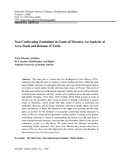Non-conforming femininity in Game of Thrones: An analysis of Arya Stark and Brienne of Tarth

View/
Date
2020Author
Trejo Morales, Cristina
Metadata
Show full item recordUsage
This item's downloads: 205 (view details)
Recommended Citation
Trejo Morales, Cristina. (2020). Non-conforming femininity in Game of Thrones: An analysis of Arya Stark and Brienne of Tarth. Dearcadh: Graduate Journal of Gender, Globalisation and Rights, 1. doi:https://doi.org/10.13025/4nzq-hb04
Published Version
Abstract
The male gaze is a theory that was developed by Laura Mulvey (1975),
addressing the objectification of women in classic Hollywood films. While the male
gaze is highly criticized, it is still applicable today and is presented in the representation
of women in current media, like the television show Game of Thrones. The power of
the male gaze can be seen in the female character’s nudity, the sexual violence directed
towards female characters, and how women access political power through sexuality
and fertility (Ferreday, 2015; Genz, 2016; Frankel, 2014). While women in Game of
Thrones are not powerless, their access to power is through conforming to typical
forms of femininity, which means that their access to power is restrained and
controlled. However, not all female characters conform to gender ideals, like Arya
Stark and Brienne of Tarth. The objective of this paper is to examine how the male
gaze can account for the treatment of non-gender-conforming female characters in
Game of Thrones, using feminist qualitative content analysis. Looking at non-genderconforming characters is critical to understanding the diverse ways the male gaze is
used to punish female characters, coercing them into femininity. Based on the analysis
undertaken as part of a MA thesis, this paper found that although non-genderconforming female characters were given more liberties than female characters in
Game of Thrones, they were still subjected to the control, coercion, and discipline of
the male gaze, even if in non-sexual ways.

